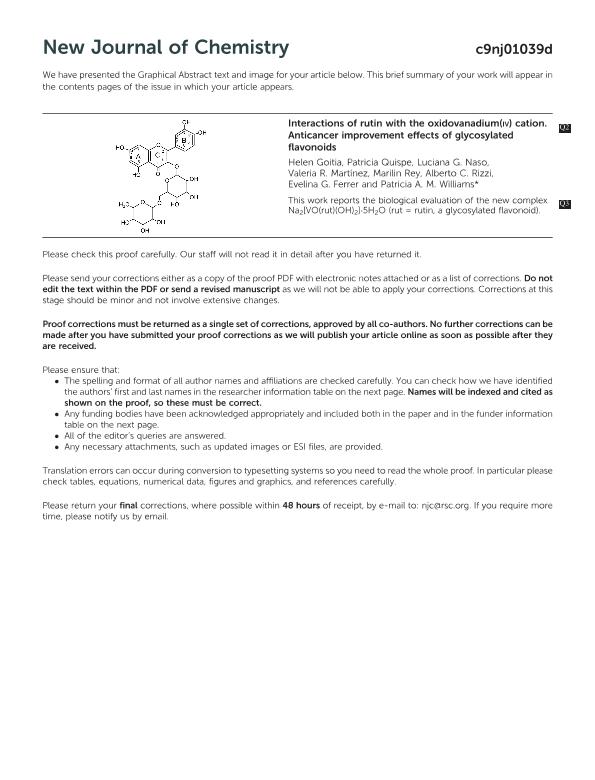Artículo
Interactions of rutin with the oxidovanadium( iv ) cation. Anticancer improvement effects of glycosylated flavonoids
Goitia Semeco, Helen Rosmary ; Quispe Castillo, Patricia Araceli
; Quispe Castillo, Patricia Araceli ; Naso, Luciana Gissella
; Naso, Luciana Gissella ; Martínez, Valeria R.; Rey, Marilin; Rizzi, Alberto C.; Ferrer, Evelina Gloria
; Martínez, Valeria R.; Rey, Marilin; Rizzi, Alberto C.; Ferrer, Evelina Gloria ; Williams, Patricia Ana María
; Williams, Patricia Ana María
 ; Quispe Castillo, Patricia Araceli
; Quispe Castillo, Patricia Araceli ; Naso, Luciana Gissella
; Naso, Luciana Gissella ; Martínez, Valeria R.; Rey, Marilin; Rizzi, Alberto C.; Ferrer, Evelina Gloria
; Martínez, Valeria R.; Rey, Marilin; Rizzi, Alberto C.; Ferrer, Evelina Gloria ; Williams, Patricia Ana María
; Williams, Patricia Ana María
Fecha de publicación:
06/2019
Editorial:
Royal Society of Chemistry
Revista:
New Journal of Chemistry
ISSN:
1144-0546
Idioma:
Inglés
Tipo de recurso:
Artículo publicado
Clasificación temática:
Resumen
This work reports the biological evaluation of the new complex Na2[VO(rut)(OH)2]·5H2O (rut = rutin, a glycosylated flavonoid). The complex was different in its coordination mode (catechol-like) from those previously reported, [VO(rutin)(H2O)2]2(SO4)·4H2O and [VO(rut)2]·4H2O (acetylacetonate-like coordination). Due to the coordination mode, the complex only improved the antioxidant activity of the ligand against superoxide and hydroxyl radicals. The results show that while both 100 µM rutin and V(IV)O did not exhibit cytotoxic activity on A549 cells, the complex selectively improved the anticancer effect (IC50 = 95 µM), cellular reactive oxygen species (ROS) generation and depletion of the non-enzymatic antioxidant glutathione (GSH), producing oxidized glutathione (GSSG), and it did not affect the viability of the normal embryonic lung cell line (MRC-5) (up to 100 µM). All these data, and given the reversion of the cell killing effect of the complex upon treatment with the antioxidant agent N-acetyl-L-cysteine (NAC), suggested an oxidative stress mechanism. Rutin and VOrut can spontaneously bind bovine serum albumin (BSA) and they can be stored and transported by the protein.
Palabras clave:
RUTIN
,
COMPLEX
,
ANTICANCER
Archivos asociados
Licencia
Identificadores
Colecciones
Articulos(CEQUINOR)
Articulos de CENTRO DE QUIMICA INORGANICA "DR. PEDRO J. AYMONINO"
Articulos de CENTRO DE QUIMICA INORGANICA "DR. PEDRO J. AYMONINO"
Citación
Goitia Semeco, Helen Rosmary; Quispe Castillo, Patricia Araceli; Naso, Luciana Gissella; Martínez, Valeria R.; Rey, Marilin; et al.; Interactions of rutin with the oxidovanadium( iv ) cation. Anticancer improvement effects of glycosylated flavonoids; Royal Society of Chemistry; New Journal of Chemistry; 6-2019; 1-11
Compartir
Altmétricas



